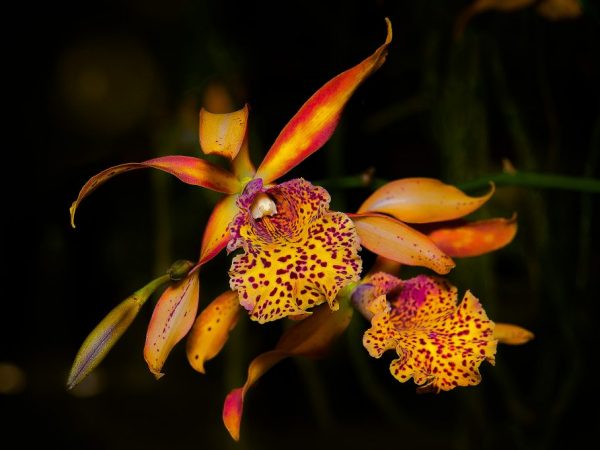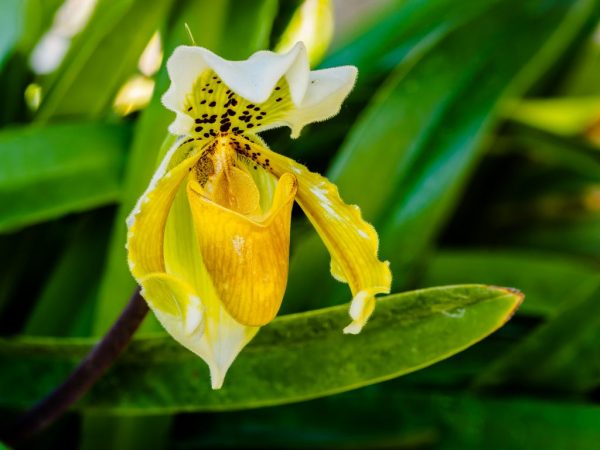Phalaenopsis orchid leaves turn yellow
Florists often face problems when growing orchids. Many do not know why the leaves of the phalaenopsis orchid turn yellow. Such symptoms do not mean that the plant is dying. There are also natural causes of leaf yellowing.

Phalaenopsis orchid leaves turn yellow
Why do the leaves turn yellow
The yellowed lower leaves in various indoor and garden flowers are the result of a normal wilting process. Phalaenopsis does not have a strong green mass.
Phalaenopsis leaves turn yellow and only then fall off. And at the Nobile, all the leaves may even crumble. Yellowing occurs along the edge and is directed along the entire plate, and as a result, the leaf turns white, dries and dies off. Usually the leaves of the phalaenopsis turn yellow below, near the roots.
You can not cut off a leaf that has turned yellow, so as not to harm the flower. He himself will disappear when his life cycle ends.
It is worth worrying if a couple of leaves have reached a yellow color along the edge and development is growing rapidly.
Wrong watering regime
Phalaenopsis reacts equally to both a deficiency and an excess of moisture. If you water the roots from above, they may not get all the nutrients. Through the drainage, water flows into the pan, and the base of the roots does not have time to be saturated.
To correct the situation, water by immersion method. Pour water into a vessel into the water and lower the pot with the plant there for a couple of minutes. After some time, the flower will return to normal.
Phalaenopsis orchid leaves turn yellow due to excessive watering. To determine if the phalaenopsis needs watering, raise the pot. Wet soil is heavier than dry soil. With an excess of moisture, the quet changes the entire plant, and the leaves become moist and soft. In addition, there is the likelihood of black dots appearing on the leaf plate, and of course, darkening of the roots.
For those who first decided to grow phalaenopsis, it is better to choose a transparent container. In them, it is easy to determine whether it is time for watering.
Water quality
Phalaenopsis does not like tap water, because chlorine, which is used to disinfect it for drinking, does not suit him at all.
Also, she is moody towards hard water. When the soil dries up, a light, salty coating appears in the pot, which means that the flower should be transplanted. However, if the phalaenopsis is blooming, then it is not worth replanting. It is better to do this at the end of flowering.
Lighting
Different types of phalaenopsis perceive light in different ways. Some wither at the slightest shadow, others bloom calmly. But in any case, everyone needs lighting. If you put a flower in the shade, then its leaves may turn yellow. And with too long time in the sun and with direct rays, burns in the form of spots are possible. Watch your plant, in the summer - find a place so that there is a sufficient amount of light and the leaf plates do not overheat.
If you have nowhere to move the pot, be sure to cover it with a curtain or flowers standing next to it. If the plant is burned, then do not immediately pluck the damaged leaves.Let the phalaenopsis stand and it will cope with the healing of wounds on its own. Light problems are eliminated with phytolamps. Set the light flow correctly, otherwise it will lead to big burns, like from the sun. Before installing, you should read the instructions.
Fertilizer for orchids

Be sure to fertilize the orchid
When buying ready-made fertilizers, it is worth considering that the same is not suitable for all types. Often, the lower leaves of the phalaenopsis turn yellow from fertilizers. A mistake is the use of active fertilizers.
To maintain a healthy appearance, the flower in stores is heavily fed. In a new place, orchid leaves may fall. It is not worth feeding for a couple of weeks after purchase. He needs to get used to a new place, environment. And then fertilize the orchid when watering every other time. This mode is suitable during growth and flowering periods, that is, in summer and spring. But the winter dressing should be reduced to one 1 p. per month. If the leaves have formed, feeding is no longer required.
In the first month of transplantation, the orchid is not fertilized. Diseased plants are not fed either. The root is weakened and cannot cope with the absorption of nutrients.
Batteries
According to the quality and condition of the leaf plates, it is determined which batteries are missing. When the tips of the leaves turn yellow, the plant receives excess calcium and it is worth changing the soil completely.
If there is a lack of potassium, the flower turns yellow at the beginning of the trunk. The streaks of withering away will be noticeable. When it is lacking, old foliage suffers. The solution to this situation is to transplant to a new land.
Diseases and pests
If the leaves of the phalaenopsis orchid turn yellow, fungal diseases may be the cause. Carry out the treatment only after finding out the cause of their appearance.
Spider mite
It can be recognized by the thin white cobweb below and on the stem and dots at the bite sites. As soon as you see the symptoms, you should immediately remove the plant from healthy flowers. Wash the foliage with water and soap diluted in it. If after the procedure a tick was found again, then additional drugs are used for treatment:
- Karbofos;
- Neoroi;
- Thiophos.
Aphid
If the leaves of the phalaenopsis orchid turn yellow and at the same time they are sticky, then the plant has undergone an invasion of aphids. It lives on the outside of the leaf. Aphids feed on sap, sprinkle poison and carry infections. Fighting with it will not be difficult. It is afraid of dryness and chemicals. The flower is washed with soapy water and processed with Fitoverm.
Shield
The growths on yellowing leaves are the result of the vital activity of scale insects. To combat the pest, the leaves are washed and ground with a solution of olive oil and water. Add 2 tbsp to 1 liter of water. tablespoons of oil.
Thrips
A silvery shade and the appearance of dots indicates the appearance of thrips. They are almost invisible. Rinse the plant and clean up damaged areas to living tissue and treat with an insecticide.
Fungus
Yellow spots indicate fungus. Remove sore spots with a knife and treat with fungicide.
Conclusion
Having studied all the reasons why the leaves of the phalaenopsis orchid turn yellow, start fighting them and their consequences. With timely treatment, the recovery orchid will delight with its flowering for many years.


